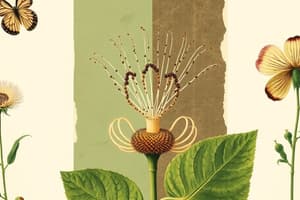Podcast
Questions and Answers
What is the main purpose of the myriads of flowers mentioned in the text?
What is the main purpose of the myriads of flowers mentioned in the text?
- To provide aesthetic pleasure to humans
- To aid in sexual reproduction (correct)
- To attract insects for pollination
- To be used for selfish purposes
Why are flowers considered objects of aesthetic, ornamental, social, religious, and cultural value?
Why are flowers considered objects of aesthetic, ornamental, social, religious, and cultural value?
- Because they are only used for conveying human feelings
- Because they have no other value
- Because they are not involved in any biological processes
- Because of their aesthetic, ornamental, social, religious and cultural significance (correct)
What is the range of adaptations in flowers aimed at ensuring?
What is the range of adaptations in flowers aimed at ensuring?
- Attracting insects for pollination
- Formation of fruits and seeds (correct)
- Increasing flower fragrance
- Aiding in selfish human activities
What is the significance of the rich colors of flowers?
What is the significance of the rich colors of flowers?
Why are plants considered lucky for reproducing sexually?
Why are plants considered lucky for reproducing sexually?
What is the purpose of inflorescences, flowers, and floral parts?
What is the purpose of inflorescences, flowers, and floral parts?
What is the main function of the androecium in a flower?
What is the main function of the androecium in a flower?
If you were to collect a stamen each from ten different flowers, what would you be able to appreciate?
If you were to collect a stamen each from ten different flowers, what would you be able to appreciate?
What is the structure called that consists of a long and slender stalk and a terminal generally bilobed structure?
What is the structure called that consists of a long and slender stalk and a terminal generally bilobed structure?
What does a typical angiosperm anther consist of?
What does a typical angiosperm anther consist of?
What is the main function of the gynoecium in a flower?
What is the main function of the gynoecium in a flower?
What is referred to by the term 'floriculture'?
What is referred to by the term 'floriculture'?
What does a typical stamen consist of?
What does a typical stamen consist of?
What are the two most important units of sexual reproduction in a flower?
What are the two most important units of sexual reproduction in a flower?
Which part of a flower is responsible for leading to differentiation and further development of floral primordium?
Which part of a flower is responsible for leading to differentiation and further development of floral primordium?
What type of pollination is more common amongst abiotic pollinations?
What type of pollination is more common amongst abiotic pollinations?
What kind of pollen grains are required for wind pollination?
What kind of pollen grains are required for wind pollination?
What is a familiar example of wind-pollinated flowers mentioned in the text?
What is a familiar example of wind-pollinated flowers mentioned in the text?
What is the purpose of wind-pollinated flowers having well-exposed stamens?
What is the purpose of wind-pollinated flowers having well-exposed stamens?
Why do wind-pollinated flowers produce an enormous amount of pollen?
Why do wind-pollinated flowers produce an enormous amount of pollen?
What is the main function of the large, often-feathery stigma in wind-pollinated flowers?
What is the main function of the large, often-feathery stigma in wind-pollinated flowers?
What is the primary mode of pollination in most aquatic plants such as water hyacinth and water lily?
What is the primary mode of pollination in most aquatic plants such as water hyacinth and water lily?
What is the mode of transport for male gametes in lower plant groups such as algae, bryophytes, and pteridophytes?
What is the mode of transport for male gametes in lower plant groups such as algae, bryophytes, and pteridophytes?
Which of the following is a common example of a water-pollinated plant?
Which of the following is a common example of a water-pollinated plant?
What is the reason for the lack of colorful and nectar-producing flowers in both wind and water-pollinated plants?
What is the reason for the lack of colorful and nectar-producing flowers in both wind and water-pollinated plants?
In Vallisneria, how are the male flowers or pollen grains released for pollination?
In Vallisneria, how are the male flowers or pollen grains released for pollination?
Why are most water-pollinated species' pollen grains protected by a mucilaginous covering?
Why are most water-pollinated species' pollen grains protected by a mucilaginous covering?
What is the primary mode of transport for pollen grains in seagrasses, a group of water-pollinated plants?
What is the primary mode of transport for pollen grains in seagrasses, a group of water-pollinated plants?
Why are wind and water-pollinated flowers not very colorful?
Why are wind and water-pollinated flowers not very colorful?
Flashcards
Significance of Flowers
Significance of Flowers
Flowers hold aesthetic, ornamental, social, religious, and cultural importance.
Floral Adaptations
Floral Adaptations
Flowers have adaptations like colors and fragrance to attract pollinators.
Sexual Reproduction Advantage
Sexual Reproduction Advantage
Sexual reproduction in plants allows for genetic diversity and increased survival chances.
Inflorescences & Floral Parts
Inflorescences & Floral Parts
Signup and view all the flashcards
Androecium & Gynoecium Roles
Androecium & Gynoecium Roles
Signup and view all the flashcards
Wind-pollinated Flower traits
Wind-pollinated Flower traits
Signup and view all the flashcards
Feathery Stigma Function
Feathery Stigma Function
Signup and view all the flashcards
Water-Pollinated Flowers
Water-Pollinated Flowers
Signup and view all the flashcards
Hydrophily
Hydrophily
Signup and view all the flashcards
Mucilaginous Covering Function
Mucilaginous Covering Function
Signup and view all the flashcards
Seagrass Pollination
Seagrass Pollination
Signup and view all the flashcards
Absent Features in Some Flowers
Absent Features in Some Flowers
Signup and view all the flashcards
Study Notes
Flowers and Their Significance
- Flowers are objects of aesthetic, ornamental, social, religious, and cultural value due to their beauty, fragrance, and symbolic meanings.
- The myriads of flowers serve as a means of ensuring reproduction, primarily through pollination and fertilization.
Adaptations in Flowers
- Flowers have evolved a range of adaptations to ensure successful pollination, including colorful appearances, fragrance, and nectar production.
- The rich colors of flowers play a significant role in attracting pollinators, such as insects, birds, and mammals.
Reproductive Significance
- Plants are considered lucky for reproducing sexually, as it allows for genetic diversity and increased chances of survival.
Inflorescences, Flowers, and Floral Parts
- Inflorescences, flowers, and floral parts have evolved to facilitate pollination and fertilization, ensuring the reproduction of plants.
Androecium and Gynoecium
- The androecium in a flower is responsible for producing pollen, while the gynoecium is responsible for containing the ovules where fertilization takes place.
- A typical stamen consists of a filament, an anther, and pollen grains, while a typical angiosperm anther consists of four pollen sacs.
Pollination
- Wind-pollinated flowers have well-exposed stamens and produce an enormous amount of pollen to increase the chances of successful pollination.
- The large, often-feathery stigma in wind-pollinated flowers serves as a receptor for pollen grains.
- Water-pollinated flowers, such as those found in aquatic plants like water hyacinth and water lily, rely on water as the primary mode of pollination.
- In lower plant groups, such as algae, bryophytes, and pteridophytes, male gametes are transported through water.
Water-Pollinated Plants
- In Vallisneria, male flowers or pollen grains are released for pollination through a process called hydrophily.
- Pollen grains in water-pollinated plants are often protected by a mucilaginous covering to prevent water from interfering with fertilization.
- Seagrasses, a group of water-pollinated plants, rely on water currents to transport pollen grains.
Characteristics of Wind and Water-Pollinated Flowers
- Wind and water-pollinated flowers tend to lack colorful and nectar-producing features, as these are not necessary for successful pollination.
- These types of flowers often have adaptations that facilitate pollination through wind or water, such as well-exposed stamens or mucilaginous coatings on pollen grains.
Studying That Suits You
Use AI to generate personalized quizzes and flashcards to suit your learning preferences.





